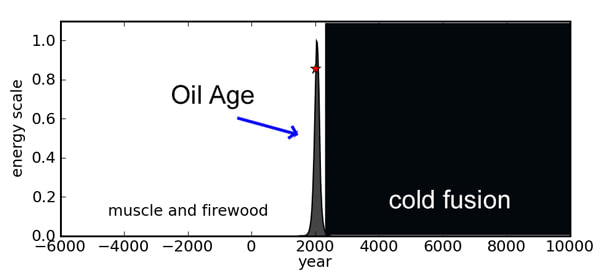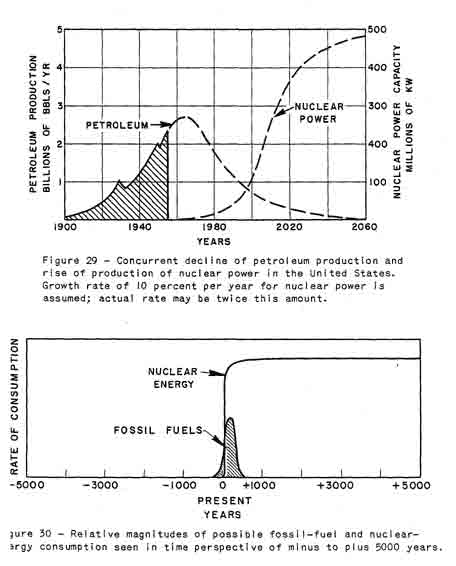[latexpage]
We are living in a world dependent on a finite source of fuel subject to M. King Hubbert’s production curve over time. This graph is from his 1956 Nuclear Energy and Fossil Fuels. It shows an increase in petroleum production, the production reaching a peak, and then, production falling.
Since 2005, global oil production has remained flat.
The Post Carbon Institute‘s video YOU ARE HERE: The Oil Journey recounts the century-and-a-half Oil Age and gives a context for Peak Oil, whose effects we live with now on the down-slope of the curve. Narrated by the great documentary voice of Peter Coyote, the half-hour video profiles the relationship between the economic and social benefits gained from fossil fuel energy, benefits that are now altering as access to fossil fuel becomes more difficult.
Fossil fuels are “concentrated and portable”, but most of the easily accessed oil, coal and gas is gone. What remains is harder to retrieve, of a lower quality, more costly to produce, and coming with a continually diminishing Energy Return on Energy Invested ERoEI.
The PCI comprises a group of researchers and writers gathered together to sound the alert on Peak Oil, the condition of a peak in production in oil, and develop strategies that will allow human communities to survive a post-petroleum world. They believe a Renewable Energy Economy based on conventional alternative energy is inevitable, but it will be “smaller, slower and more localized”.
Alternatives “should be invested in”, but a problem remains. The ERoEI for conventional alternatives like solar and wind is not nearly as high as fossil fuels like oil, coal, or gas. According to their 2009 report, PCI concludes that “None of the conventional alternative energy sources will maintain our current energy level of use” and “The amount of investment capital to develop the technology is just not there”.
Like many in the Peak Oil-Collapse community, PCI is wary of believing there will “always be a new technology to come along” to keep the economy going. They are skeptical of the attitude that “only innovation and investment can solve our environmental problems”.
And I would too, if I didn’t already know of the solution that cold fusion offers.
Cold fusion scientists generally refer to Energy Return, a simple ratio of thermal Energy Out to equivalent electrical Energy In. The first prototypes of commercial cold fusion are steam generators that have demonstrated energy returns of 400 and higher.
However, as the technology is based on a not-fully-understood reaction between hydrogen and a bit of metallic powder, initial technologies for agency and industrial use are claiming more modest 6 to 25 times thermal energy return over the equivalent electrical energy input.
But the potential is even greater. This is a nuclear fusion-sized power which could provide an energy density a hundred-million times greater than the chemical burning of fossil fuels.
Cold fusion uses a fuel of hydrogen H and its isotope deuterium D, both found in water. One in every 6400 hydrogen atoms in the ocean is a deuterium atom. Deuterium combined with oxygen makes heavy water D20, just like hydrogen combined with oxygen can form regular water H20.
Researcher Jed Rothwell, author of Cold Fusion and the Future, writes of the abundance of deuterium, the first form of hydrogen to be used in cold fusion:
“There are $2 \hspace{1 mm} \times \hspace{1 mm} 10^{13}$ tons of heavy water on earth, enough to last 3.2 billion years at present energy consumption rates.”
But since simple hydrogen also works, this guarantees a virtually inexhaustible fuel source.
Regarding energy density, he writes:
“Deuterium fusion yields $3.45 \hspace{1 mm} \times \hspace{1 mm} 10^{14}$ joules per kilogram (345 million megajoules).
Gasoline has 45 megajoules per kilogram (or 132 megajoules per gallon).
Therefore, a kilogram of deuterium gas has roughly as much energy as 7.6 million kilograms of gasoline (2.6 million gallons).” [p 33]
The metals that “host” the reaction are transition metals like palladium and nickel. Only a few grams are needed for tens of kilowatts of thermal energy. The 1.25 grams of nickel contained in one US 5 cent piece could generate as much energy as in 5 barrels of oil. Only a tiny portion of the metal is consumed in the reaction; the rest is recyclable.
The first commercial cold fusion generators make steam, not electricity. Currently, independent labs are working to make the steam viable to turn a turbine, and create electrical power. When the electricity generated is used to power the generator, then we have a new level of energy return.
Peak Oilers have verified the predictions of M. King Hubbert’s fossil fuel production curve, but haven’t looked to the right-hand side of the graph, and our nuclear energy future.
There is no fission nuclear future using dangerous and dirty radioactive fuel.
There is no hot-fusion mega-facilities ready to come online any time soon.
But there is a third choice in nuclear power. Cold fusion.
Clean, abundant, energy-dense, and revolutionary.
Thanks to Peak Oilers, we now know where we’re at.
Let’s start looking at where we want to be.

Cold Fusion Now!
Related Links
M. King Hubbert on Nuclear Energy by Ruby Carat March 22, 2011
New PCI Study Concludes No Combination of Alternative Energy Systems Can Replace Fossil Fuels by Richard Heinberg November 13, 2009
Answering “Nine Critical Questions to Ask About Alternative Energy” by Jed Rothwell January 20, 2011
Cold Fusion and the Future by Jed Rothwell download .pdf
Oil to Nickel: The Ecat Energy Equivalence by Ruby Carat October 4, 2011



For the first time in human history, we will have access to virtually unlimited energy for virtually no cost (and clean to boot!). It will be very interesting to see the sociological effect such a dramatic difference will cause. We will be able to escape this rock and colonize outer space!
Well, at least SOME of outer space. With consideration to other populations that may be living on planets / moons we visit. Hopefully we will learn from our mistakes colonizing Earth. And be far more circumspect in our space adventures.
Peter Coyote has a great voice for narration.